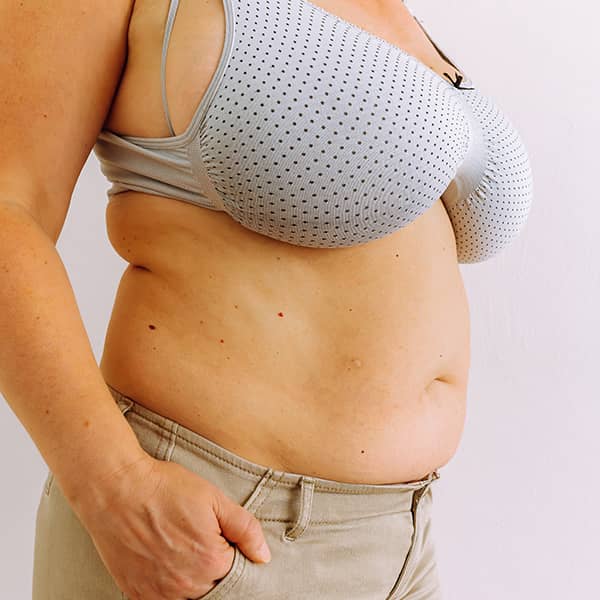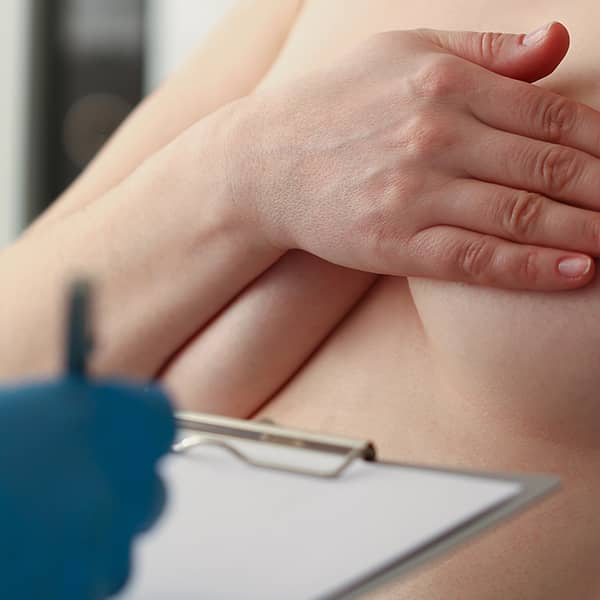Breast Reduction
A breast reduction (reduction mammoplasty) is a surgical procedure that removes excess breast tissue, fat, and skin from the breasts. It can also help reduce the areola’s size, the dark area surrounding the nipple.
There are several reasons why a woman might choose to have a breast reduction. Some women feel self-conscious about their breast size and want to reduce them for aesthetic reasons. Others may have chronic pain in the back, neck, or shoulders due to the extra weight of their heavy breasts.
You Are a Good Candidate If
- You are in good health
- You are realistic about the outcome
- You are a non-smoker
- Your breasts limit your ability to perform physical activities
- You have indentations from your bra straps
- Your breast skin is stretched
- You have large areolas because the skin is stretched
- You have sweating and rashes underneath your breasts

The Benefits
- A more proportionate figure
- Reduced back, neck and shoulder pain
- Improved posture
- Relief from skin irritation under the breasts
- Better hygiene and less sweating and rashes
The Risks
- Anesthesia risks
- Bleeding and infection
- Blood clots
- Changes in sensation in the breasts
- Scarring
- Unsatisfactory results
- Loss of sensation in the nipple
As with any major surgery, there are some risks associated with breast reduction. However, most women who have a breast reduction experience no complications.
Types of Breast Reduction Surgery
Liposuction:
Liposuction is a breast reduction surgery that removes excess fat from the breasts. This procedure is often combined with other types of breast reduction surgery, such as a breast lift. A breast lift, also known as a mastopexy, removes excess skin from the breasts, which can help to improve their shape and appearance. If breast size is due primarily to fatty tissue and there is no excess skin, you may only require liposuction.
Vertical Lollipop Incision:
A vertical lollipop incision is a type of breast reduction surgery that involves making an incision around the areola and then vertically down to the crease underneath the breast.
Inverted T (anchor) Incision:
An inverted T incision is a type of breast reduction surgery that involves making an incision around the areola and then horizontally along the crease underneath the breast. The horizontal incision continues until it meets up with the vertical incision.
Breast Lift Surgery
A breast lift, also known as a mastopexy, is performed on sagging breasts that need to be raised and reshaped. If your breasts are small or have lost volume, you may also opt to have breast implants inserted during your breast lift surgery. This can help to improve their shape and appearance.
A breast lift is different from a breast reduction because it does not involve the removal of any excess fat from the breasts. A breast lift is typically done on women who have breastfed or lost a significant amount of weight and have excess skin.
The best candidates for breast lift surgery are :
- Non-smokers
- Women who have finished having children
- Women with small, sagging breasts
- Women with a good skin elasticity
Breast Lift Surgery Procedure
The surgeon will make an anchor-like incision around the areola and then vertically down to the crease underneath the breast. The horizontal incision continues until it meets up with the vertical incision.
After making the incisions, the surgeon will remove excess skin and reshape the breast. The nipple and areola will be moved to a new position. The skin around the areola will be tightened, and the areola will be reduced in size if necessary.
After the surgeon has removed the excess skin and reshaped the breast, they will close the incisions with stitches. A drainage tube may also be placed under each breast to help drain any excess fluid.
The Consultation
If you are considering breast reduction surgery, it is important to consult with a board-certified plastic surgeon. Your surgeon will assess your needs and goals during your consultation to determine if breast reduction surgery is right for you. They will also discuss the different types of breast reduction surgery and the risks and potential complications associated with the procedure. Typically the surgery is an outpatient procedure and only takes a few hours.
The surgeon will ask for a detailed medical history and perform a physical examination. Be sure to tell your surgeon about any medications you are taking and any allergies you may have.
The surgeon will measure your breasts and take photos of them for your medical record. They will also assess the breast shape and size and the amount of excess skin and fat.
You should come prepared with any questions you may have about the surgery. This is your opportunity to get all of the information you need to make an informed decision about whether or not breast reduction surgery is right for you.
After your consultation, you will be given specific instructions on how to prepare for your surgery and what to expect during and after the procedure. You should make sure you understand all of the instructions before scheduling your surgery.

Preparing For Surgery
It is important to follow your surgeon’s instructions on preparing for your surgery. You will likely be asked to
- Get a mammogram
- Stop taking certain medications
- Stop smoking
- Avoid drinking alcohol
- Eat a healthy diet
- Exercise regularly
Breast Reduction Surgery Recovery
After your surgery, you will likely experience some swelling, bruising, and discomfort. Your breasts will be wrapped in gauze and you will need to wear a surgical bra during your recovery. It is important to avoid strenuous activity for at least four weeks after your surgery. You should also avoid lifting anything heavier than 10 pounds. Most women report feeling much better after two to three weeks. However, it may take up to 12-16 weeks for the swelling to completely subside. It is important to follow your doctor’s instructions during your recovery to ensure a smooth and successful healing process.

Breast Reduction Surgery in Bakersfield CA
Breast reduction surgery is a safe and effective way to reduce the size of your breasts, and the surgery can also help improve your self-esteem and quality of life. If you are ready to take the next step, contact Dr. Freeman to book a consultation at his Bakersfield clinic. Fill out the contact form to book an appointment. We look forward to meeting you!
Frequently Asked Questions
There will be some scarring after your surgery, although the scars will eventually fade. The type of incision used will determine the location and size of the scars. For example, if you have a vertical lollipop incision, the scar will be around the areola and vertically down to the crease underneath the breast.
Depending on what type of stitches are used, you may need to have them removed within one to two weeks after your surgery. In most cases, dissolvable stitches are placed underneath the skin and do not require removal.
You will likely experience some pain and discomfort after your surgery. Your pain can be controlled with medication and should improve within a few days.
No, a breast reduction does not reduce your chances of getting breast cancer. However, having smaller breasts may make it easier to detect breast cancer at an early stage.
The size of your breasts after surgery will depend on your individual goals and preferences. Your surgeon will work to achieve the size and shape you desire.
The nerves in the nipple area are usually not affected by breast reduction surgery. However, if the nerves are damaged, it is possible you may experience numbness or tingling in your nipples, however, this change is usually temporary.
No, you do not need to lose weight before surgery. However, it is important to be at a healthy weight to reduce the risks associated with surgery.
You should avoid strenuous activity for at least four weeks after your surgery. Your surgeon will provide you with specific instructions on when to resume normal activities and you will be given further instructions during your recovery process and visits.
Because a breast reduction is considered to be a reconstructive procedure, getting insurance coverage is possible for the procedure. It is best to check with your insurance company prior to surgery.
